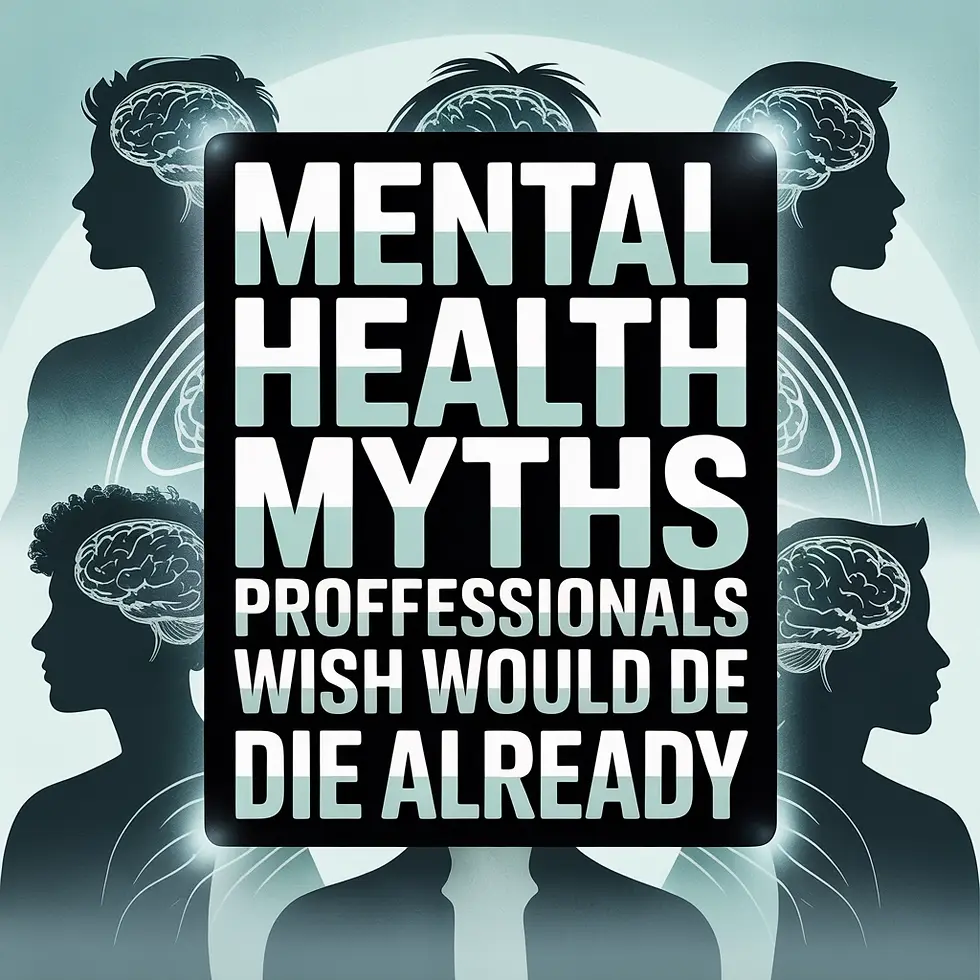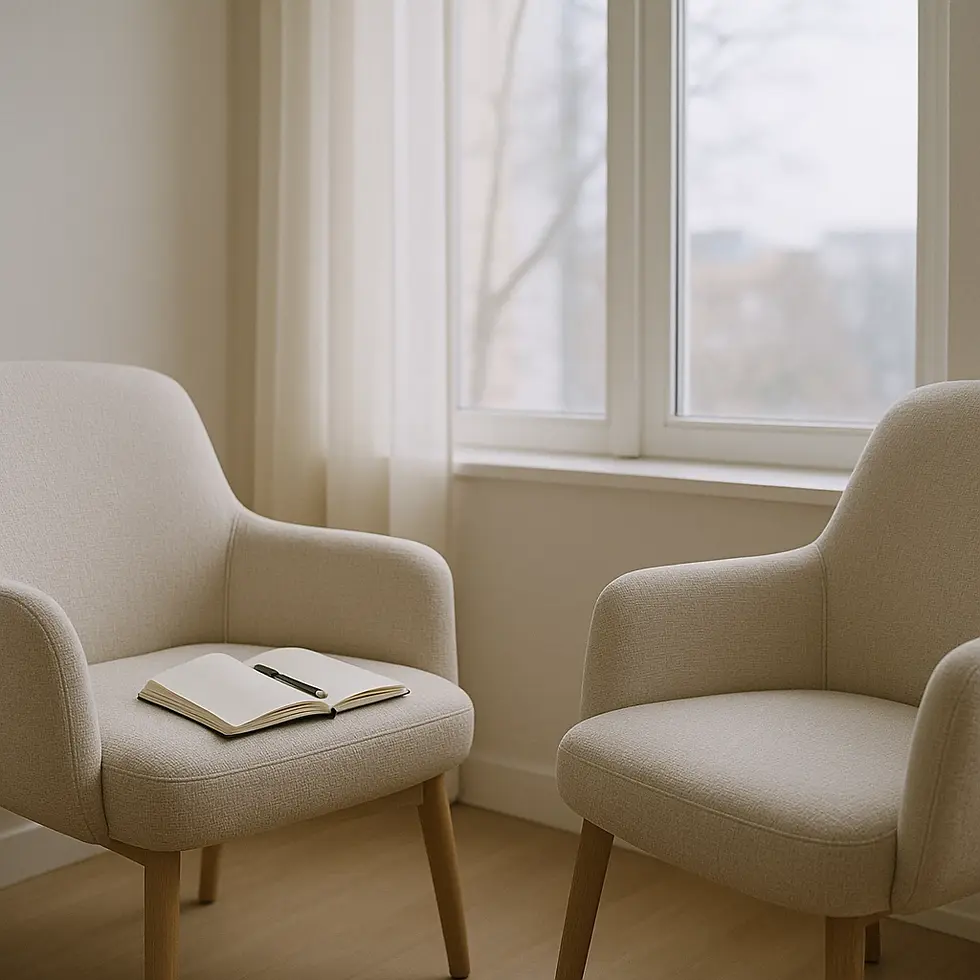Mental Health Myths Professionals Wish Would Die Already
- 3 days ago
- 5 min read

Let's be honest, no matter how many degrees hang on our walls or how many hours we log in session, we’re still battling the same outdated mental health myths… again and again. Clients internalize them. Families reinforce them. And somehow, society keeps dusting them off like they’re fresh insights.
We know better. But that doesn’t mean we don’t get tired of repeating ourselves. So consider this blog your professional sigh, your “if I had a dollar for every time I heard this,” and your nudge to push back with facts (and maybe just a touch of snark).
Myth #1: "Mental Health Struggles = Weakness"
You’ve probably had at least one client whisper, “I know this sounds crazy, but…” or “I feel like a failure because I can’t just snap out of it.” And if you’re anything like us, you’ve got a whole inner monologue queued up every time.
The Reality: Mental health challenges aren’t character flaws. They’re biopsychosocial conditions influenced by genetics, environment, trauma, and more.
As Dr. Maya Richards, a psychologist in our MHM network, puts it:
“I’ve watched clients push through panic attacks just to show up to work or parent their kids. That’s not weakness. That’s grit on overdrive.”
We already know the research—neuroimaging confirms structural and chemical differences in brains impacted by depression, PTSD, anxiety, and beyond. Yet somehow we’re still fighting off the “just be positive” narrative like it’s 2003.
Let’s normalize reminding clients (and sometimes ourselves): strength doesn’t look like invulnerability. It looks like showing up anyway.

Myth #2: "Therapy Is Only for People in Crisis"
If we had a nickel for every time someone said, “But nothing’s wrong—why would I need therapy?” we could fund free sessions for a year.
The Reality: Therapy isn’t just triage. It’s maintenance, prevention, and growth work.
Dr. Jonathan Lee, who specializes in mental wellness, puts it perfectly:
“Therapy is more like a gym for your mind than an emergency room. You don’t wait for a heart attack to start exercising.”
We see it in our own practices. Clients who start therapy before a full-on crisis often gain more traction and insight faster. Prevention isn’t sexy, but it’s smart—and arguably more sustainable.
Remind your clients (and their skeptical in-laws): therapy is for everyone, not just those hanging by a thread.
Myth #3: "Suicide Happens Without Warning"
You’ve heard it. After a tragic loss, people say, “We had no idea. There were no signs.” But we know better.
The Reality: Many (but not all) individuals who die by suicide do show warning signs. They just aren’t always recognized, or they’re dismissed as “just having a rough week.”
We’re trained to recognize:
Verbal cues: hopelessness, burden language, or goodbye statements
Behavior changes: withdrawing, giving away items, substance use
Mood shifts: rage, depression, numbness, or sudden calm after chaos
Crisis counselor Amara Patel reminds us:
“The myth of the ‘out-of-the-blue’ suicide keeps people from acting on the red flags they do see.”
As therapists, we’re not just safety planners—we’re myth busters. Let’s keep educating clients and communities about the nuance of suicide risk.

Myth #4: "Mental Illness Is a Life Sentence"
You’ve likely had a client say, “I guess I’ll just always be like this.” Cue the existential dread.
The Reality: Many mental health conditions are episodic, manageable, and even fully treatable. Chronic doesn’t equal doomed.
Psychiatrist Dr. Leila Jones says:
“Mental health exists on a spectrum, and recovery is very real. I’ve seen clients go from daily intrusive thoughts to years of symptom remission.”
Yes, some diagnoses require long-term care, but the data backs us up, evidence-based treatment works. People can get better.
Let’s keep dismantling the myth that a diagnosis is a dead-end. It’s often just a map for the journey ahead.
Myth #5: "Children Don't Experience Mental Health Issues"
There’s still this persistent fantasy that childhood = carefree. Meanwhile, we’re treating kids with panic attacks, trauma flashbacks, and depression before they’ve hit puberty.
The Reality: Mental health conditions can and do begin in childhood, often with non-obvious presentations.
Dr. Marcus Wong, a child psychologist, explains:
“Kids don’t always say ‘I’m anxious.’ They act out, somaticize, or withdraw. It’s our job to decode what they can’t articulate.”
Half of all lifetime disorders begin before age 14. That alone should be enough to convince policymakers and schools to pay attention (but we digress).
Our community trainings and resource guides help clinicians support young clients and educate caregivers on early signs and intervention.
Myth #6: "If You Have Supportive Friends and Family, You Don't Need Therapy"
Bless their hearts—but no. Your aunt’s pep talk is not a replacement for trauma-informed care.
The Reality: Friends and family can be incredible supports, but they’re not neutral, trained, or always emotionally safe.
As family therapist Sophia Rodriguez says:
“Your loved ones bring comfort, but they also bring bias. Therapists bring clarity, confidentiality, and clinical tools.”
It’s not either/or. It’s both/and. Community and clinical care together create stronger outcomes.
Normalize that message with clients who feel guilty about needing “extra” help. There’s no such thing as too much support.

Myth #7: "Mental Health Treatments Don't Really Work"
This one’s a dagger, especially when it comes from within our own circles.
The Reality: Evidence-based treatments for mental health are effective—often more so than treatments for physical illnesses.
Let’s hit them with the stats:
CBT = 50–80% effective for anxiety
Depression treatment success = 80% with proper care
Bipolar relapse reduction = up to 70% with combined meds and therapy
Dr. Priya Sharma, neuroscientist and MHM contributor, puts it bluntly:
“The science is there. What’s missing is access, funding, and follow-through—not efficacy.”
We owe it to our profession and our clients to stop letting this myth slide.
Breaking Free from Mental Health Myths
These myths don’t just frustrate us—they actively block people from getting better. They reinforce stigma, delay care, and oversimplify complex human experiences.
As mental health professionals, we’re myth-slaying on the daily. So here’s your reminder: you’re not alone in that work. MHM is here to back you up with resources, community, and a collective eye roll when needed.
Ready to connect with peers who get it? Join us inside the MHM portal. Forums, consult groups, live events, and a whole lot of truth-telling—minus the sugarcoating.
👉 Check out membership options here
What myth drives you up the wall? Share in the comments or start a thread in the forum. Let’s keep myth-busting together.




Comments